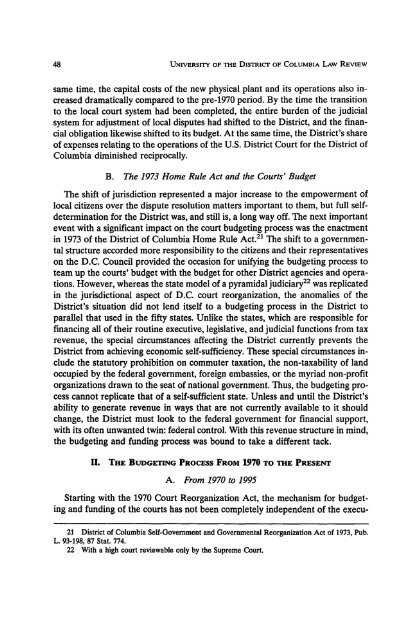Download Electronic Version - UDC Law Review
Download Electronic Version - UDC Law Review
Download Electronic Version - UDC Law Review
You also want an ePaper? Increase the reach of your titles
YUMPU automatically turns print PDFs into web optimized ePapers that Google loves.
48 UNIVERSITY OF THE DISTRIcr OF COLUMBIA LAW REVIEW<br />
same time, the capital costs of the new physical plant and its operations also increased<br />
dramatically compared to the pre-1970 period. By the time the transition<br />
to the local court system had been completed, the entire burden of the judicial<br />
system for adjustment of local disputes had shifted to the District, and the financial<br />
obligation likewise shifted to its budget. At the same time, the District's share<br />
of expenses relating to the operations of the U.S. District Court for the District of<br />
Columbia diminished reciprocally.<br />
B. The 1973 Home Rule Act and the Courts' Budget<br />
The shift of jurisdiction represented a major increase to the empowerment of<br />
local citizens over the dispute resolution matters important to them, but full selfdetermination<br />
for the District was, and still is, a long way off. The next important<br />
event with a significant impact on the court budgeting process was the enactment<br />
in 1973 of the District of Columbia Home Rule ACt. 21 The shift to a governmental<br />
structure accorded more responsibility to the citizens and their representatives<br />
on the D.C. Council provided the occasion for unifying the budgeting process to<br />
team up the courts' budget with the budget for other District agencies and operations.<br />
However, whereas the state model of a pyramidal judiciary22 was replicated<br />
in the jurisdictional aspect of D.C. court reorganization, the anomalies of the<br />
District's situation did not lend itself to a budgeting process in the District to<br />
parallel that used in the fifty states. Unlike the states, which are responsible for<br />
financing all of their routine executive, legislative, and judicial functions from tax<br />
revenue, the special circumstances affecting the District currently prevents the<br />
District from achieving economic self-sufficiency. These special circumstances include<br />
the statutory prohibition on commuter taxation, the non-taxability of land<br />
occupied by the federal government, foreign embassies, or the myriad non-profit<br />
organizations drawn to the seat of national government. Thus, the budgeting process<br />
cannot replicate that of a self-sufficient state. Unless and until the District's<br />
ability to generate revenue in ways that are not currently available to it should<br />
change, the District must look to the federal government for financial support,<br />
with its often unwanted twin: federal control. With this revenue structure in mind,<br />
the budgeting and funding process was bound to take a different tack.<br />
D. THE BUDGETING PROCESS FROM 1970 TO THE PRESENT<br />
A. From 1970 to 1995<br />
Starting with the 1970 Court Reorganization Act, the mechanism for budgeting<br />
and funding of the courts has not been completely independent of the execu-<br />
21 District of Columbia Self-Government and Governmental Reorganization Act of 1973, Pub.<br />
L. 93-198, 87 Stat. 774.<br />
22 With a high court reviewable only by the Supreme Court.














